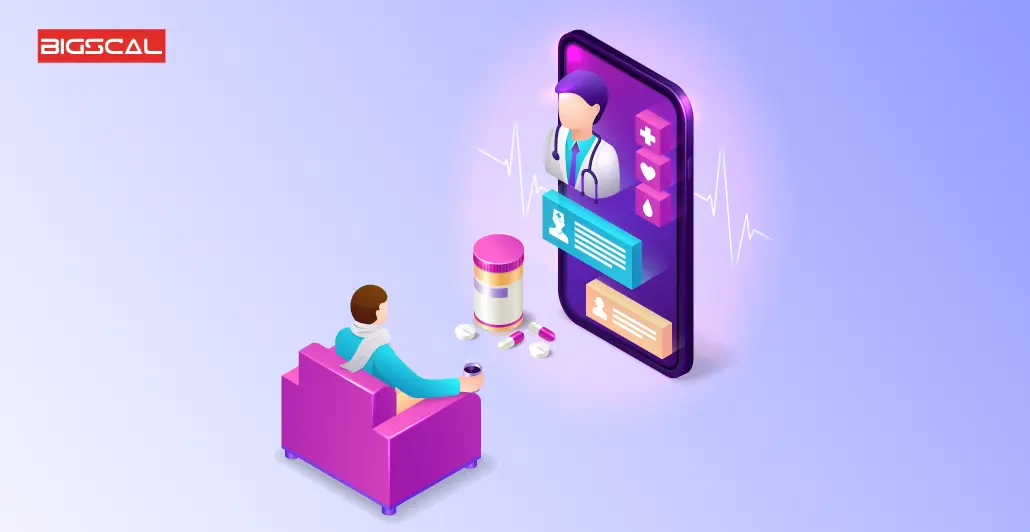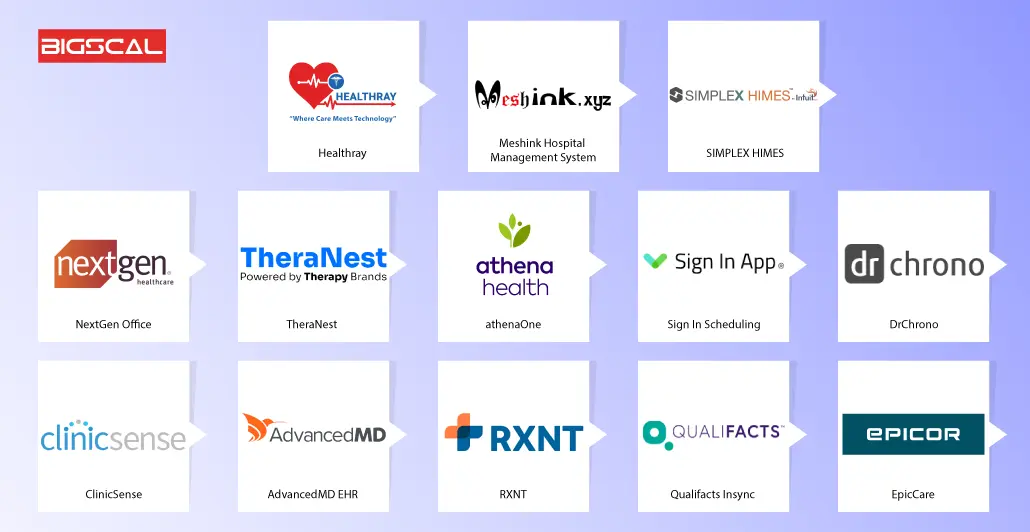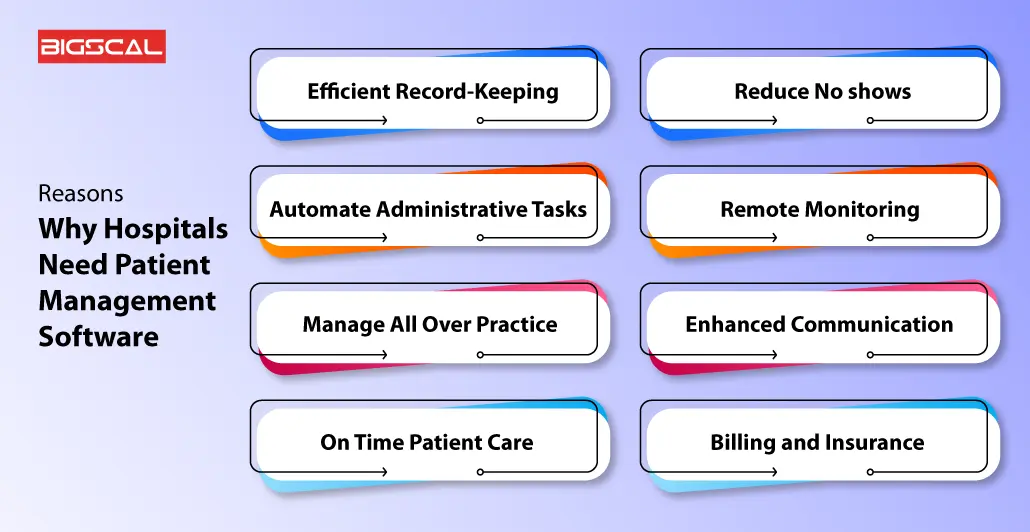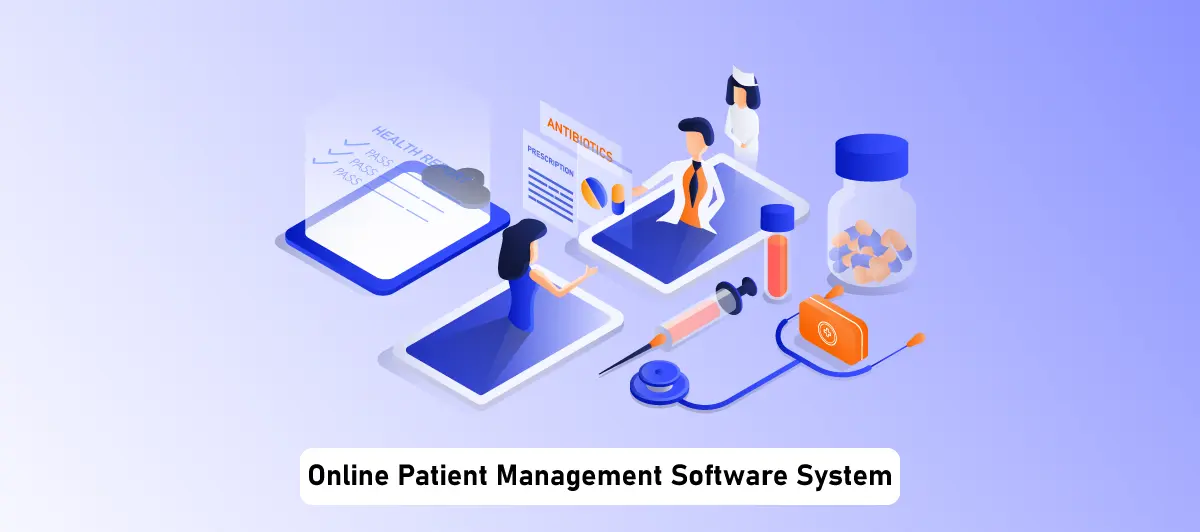Online Patient Management Software System: Why Hospitals Need This?
Quick Summary: In the last few years, things have changed drastically everywhere in every sector, and this is all due to the shift towards technology. When it comes to the hospital, the demand for patients to get more personalized health care also needs an Online Patient Management Software System. The reason to adopt this software does not end here. There are more reasons for hospitals to implement this. Check out all!
Introduction
In this era where technology is shifting towards advancements, hospitals are continually evolving their practice management systems to meet the growing demands of patient care. One of the most significant advancements that have revolutionized the healthcare industry is Online Patient Management Software Systems.
Earlier, when there was no such software for managing patients and all other hospital tasks. It was so challenging for hospitals then to handle all the charges. The management of patient records, appointment scheduling, medical billing,, and inventory control relied heavily on manual processes. Paper-based records were prone to errors, and finding patient information or medical histories was a time-consuming ordeal. Additionally, the lack of real-time data sharing made it challenging for healthcare providers to coordinate care effectively.
But… Now, there is patient management software that helps hospitals to overcome these challenges. In this blog, we will discuss all this about the most patient management systems and portal software and explain to you the importance of Online Patient Management Software Systems.
Keep reading!
An Overview To Online Patient Management Software System

Online patient management software systems are digital solutions that help hospitals manage tasks and handle patient journey. It simplifies and enhances the healthcare industry’s administrative and clinical processes. These various practice management software systems offer different platforms like the patient management systems integration, patient relationship management software, physiotherapy software, and patient complaint management software. These software manage various tasks like patient information, scheduling appointments, storing medical records, and facilitating communication between healthcare providers and patients.
They improve efficiency by reducing paperwork, automating tasks, and ensuring easy access to patient data. With features like billing and insurance, management systems, prescription tracking, and telehealth integration, these software systems enable healthcare providers to deliver better patient care while optimizing their operations.
Moreover, these systems also include billing and insurance processing features, reducing administrative burdens. Patient portals within these platforms empower patients to access their medical records, request their appointments online, and communicate with their healthcare providers conveniently. Integration of patient accounts with pharmacies and laboratories enhances prescription and diagnostic processes, fostering a more seamless continuum of care.
Read more: Most Demanding Clinical Data Management Software System
List Of Best Patient Management Software System
Let’s check out all Best Online Patient Management Software Systems:

- Healthray
- Meshink Hospital Management System
- SIMPLEX HIMES
- NextGen Office
- TheraNest
- athenaOne
- Sign In Scheduling
- DrChrono
- ClinicSense
- AdvancedMD EHR
- RXNT
- Qualifacts Insync
- EpicCare
Read more: How To Create Hospital Management Software: Step-By-Step Guide
Reasons Why Hospitals Need Patient Management Software
So, here we present the reasons why hospitals need to adopt online patient management software and how this software benefits them and helps them to improve the patient experience and care. Read Below:

Efficient Record-Keeping
Patient management software is crucial for hospitals because it streamlines the process of record-keeping. It allows medical staff to maintain organized and easily accessible patient record. Instead of sifting through mountains of paper files, doctors and nurses can quickly access digital patient information.
This not only saves time but also reduces the risk of errors in medical history documentation. When a doctor can swiftly retrieve a patient’s medical records, it leads to better-informed decisions and more accurate diagnoses. Moreover, digital records safeguard patient information that are easily transferable between departments and hospitals, making it easier to provide continuous care. In a Nutshell, patient management software ensures that vital patient data is readily available, improving the overall quality and efficiency of healthcare services.
Automate Administrative Tasks
Hospitals are bustling with administrative tasks, from appointment scheduling to billing and insurance processing. Patient management systems and software automates many of these tasks, reducing the burden on administrative staff.
For example, it can send appointment reminders to patients, handle insurance claims electronically, make intake forms and even generate invoices. Automation not only saves time and resources but also minimizes errors that can occur with manual and data entry tasks.
This frees up administrative staff to focus best patient management or on other important duties, improving the overall operational efficiency of the hospital. In simpler terms, patient management software helps hospitals run smoothly by taking care of routine administrative work, allowing staff to concentrate on patient care.
Manage All Over Practice
Patient management software is a comprehensive solution that helps hospitals to manage patients and their entire practice more effectively. This platform brings together various aspects of healthcare management, from patient records and appointments to billing and inventory management.
With all these functions integrated into a centralized platform in one system, hospitals can coordinate their operations seamlessly. This simplifies the workflow practice management and communication between different departments, ensuring a more holistic approach to patient care.
In short, this software acts as the central hub and practice management system that connects and manages all aspects of a hospital’s activities, making it easier for healthcare professionals to deliver quality care and for the hospital to function efficiently.
On Time Patient Care
It ensures on-time patient care. It helps hospitals and healthcare facilities schedule appointments efficiently, reducing patient wait times. When meetings are well-organized, doctors and nurses can stick to their schedules, minimizing delays and best patient outcomes.
This ensures that patients receive timely care and reduces their anxiety. Additionally, the software can send automated reminders to patients about their upcoming appointments, further the patient intake and improving punctuality of patient scheduling.
In emergencies, it enables quick access to health records, allowing health care providers to make faster and more accurate treatment decisions, ultimately enhancing the quality of patient care.
Reduce No shows
Online: Patient management system the software to improve patient management system helps reduce the number of no-shows, where patients miss their appointments. It does this by sending appointment reminders through various channels like SMS, email, or phone calls.
Patients are more likely to remember and attend their appointments when they receive these reminders. This not only ensures that patients receive the care they need but also optimizes the utilization of healthcare resources in medical practices. Fewer no-shows mean that appointment slots are filled, minimizing wasted time and resources in medical practice.
Read more: Types Of Telemedicine: Benefits, Types, And Examples
Remote Monitoring
Patient management software facilitates remote monitoring, which is especially valuable for patients with chronic conditions. It allows health care providers to keep track of patient info and their vital signs from a distance.
This real-time medical data, can help in the early detection of health issues, enabling timely interventions. It also reduces the need for frequent in-person visits, making healthcare more convenient for patients. Remote monitoring can improve patient outcomes and reduce the burden on hospitals, freeing up resources for more emergency cases.
Enhanced Communication
Patient management software improves communication within hospitals by allowing doctors to access patient info quickly and easily. In addition, it centralizes patient health records, and this makes it simple for doctors and hospital staff to share and update these records.
This results, medical teams can coordinate for more efficient care and treatment. It also reduces the chances of errors as it is software based. Additionally, it also includes messaging and notification features, which enable faster communication within hospitals. Moreover, it also increases patient satisfaction by immersive communication.
Billing and Insurance
This medical software also handles billing and insurance. It automates tasks such as verifying insurance coverage, submitting claims, and processing payments. In addition, this automation not only reduces administrative workload but also minimizes billing errors. It leads to fast and more accurate financial transactions and easy patient discharge. It also sends automated payment reminders to patients, which helps them not to miss out on their payments.
Patients benefit from more precise and more transparent billing statements, which boost their satisfaction in the healthcare facility. Furthermore, efficient billing and insurance management can help hospitals improve their revenue cycles and financial stability. It ensures quality care to their patients.
Better Patient Engagement
Online Patient management software enhances patient engagement. It offers online portals and mobile apps that allow patients to access their health records, schedule appointments, and communicate with their doctors. This empowers patients to take an active role in managing their health, leading to better adherence to treatment plans and better health outcomes.
Moreover, the software often sends automated reminders for appointments and medication, which further encourages patient participation. By establishing stronger patient-provider relationships and enabling convenient access to healthcare information, patient management software contributes to a more patient-centric approach.
Inventory Management
Online patient management software systems are essential for hospitals to handle their inventory of medical supplies and equipment efficiently. This software helps in tracking and managing the availability of items like medications, surgical instruments, and other medical supplies.
With real-time updates on stock levels, hospitals can prevent shortages and reduce wastage. It also aids in ensuring that expired items are promptly removed, maintaining the quality and safety of patient treatment. By automating inventory management, hospitals can save time, reduce human errors, and allocate resources more effectively, ultimately improving the patient experience and outcomes.
Reporting and Decision-Making
Patient management software is an essential tool for data collection and reporting within hospitals. It compiles patient information, treatment histories, and other relevant data, enabling healthcare professionals to make informed decisions. By analyzing this data, hospitals can identify trends, assess the effectiveness of treatments, and plan for future patient care needs.
This not only enhances patient care but also streamlines administrative processes. The software also aids in compliance with regulatory requirements by generating accurate and timely reports. In a nutshell, patient management software empowers hospitals with valuable insights, contributing to better patient outcomes, improved resource allocation, and informed decision-making.
Cost Effectiveness
Patient management software is a cost-effective solution for hospitals for several reasons. It reduces the need for paper-based records, saving money on printing and storage. Electronic health records are easier to manage and access, decreasing the risk of errors.
Additionally, it streamlines administrative tasks. Staff can now schedule appointments online, check insurance information, and manage billing more efficiently. This reduces the need for extra personnel, which can save on labor costs. It enhances communication within the hospital, improving coordination among different departments. This can lead to better patient treatment and potentially shorter hospital stays, reducing costs further.
Error Free Task Handling
Patient management software hospitals help with error-free task handling. It replaces manual processes, reducing the risk of human errors such as incorrect patient information or medication dosages. With digital records, doctors can access up-to-date patient data, leading to more accurate diagnoses and treatments.
This accuracy improves patient safety and reduces the chances of medical mistakes. Additionally, the software helps streamline administrative tasks like appointment scheduling and billing, minimizing administrative errors and enhancing overall hospital efficiency.
Read more: Patient Journey Management Software: Why Hospitals Need It
Develop an Online Patient Management Software System With Bigscal
If you need an Online Patient Management Software System for your hospital then develop it with us. Wondering why? See how;
We are the ideal partner for developing an Online Patient Management Software System due to our expertise in healthcare technology solutions. With a deep understanding of the healthcare industry, we offer a solution that streamlines patient management.
Our team of experienced developers and designers can create a user-friendly platform that enables healthcare professionals to efficiently schedule appointments, manage patient records, and facilitate seamless communication. Moreover, our commitment to data security ensures that sensitive patient information remains protected. We stay up-to-date with industry regulations, guaranteeing compliance and peace of mind.
We focus on innovation, which means the software can evolve to meet the ever-changing needs of the healthcare sector. When it comes to patient management software, our track rec
Conclusion
So, we hope you understand how an online patient management software system helps the hospital to enhance their administration workflows. We also give a list of top-notch patient management solutions. Now it’s time for you to take time and decide which patient retention software you need for your hospital.
FAQ
What is HIPAA compliant software?
Greater awareness: Understanding of HIPAA rules in our times is much higher than a few years before Greater awareness of HIPAA rules in our times is much higher than it was a few years ago This article aims to explain the specifics of HIPAA-compliant software in more detail. These programs address the protection of identifiable healthcare data and information with focus on their security and privacy, storage, transmission, and usage, which include EHR systems and communications used by providers during HIPAA compliance.
List down the Key features of the Patient Management Software System?
Key features of Patient Management Software Systems include:
- Electronic Health Records (EHR) management
- Appointment scheduling and reminders
- Billing and insurance claims processing
- Patient registration and demographics
- Prescription and medication management
- Secure patient communication
- Reporting and analytics
- Integration with other healthcare systems
- Compliance with healthcare regulations, such as HIPAA.
What is patient loyalty?
Patient loyalty in health care could be defined as the extent to which the patient is willingly and consistently associated with a definite health care firm. If the position of a patient is health-conscious, it is a positive implication, proving that they have a long-term relationship with that particular healthcare provider. It can result in repeated visits and referral of clients and other people to the clinic.
What are the steps of patient management?
The patient management process is:
- Patient Registration: Gather data against patient.
- Medical History: Maintaining the record of the existing general health status and issues.
- Examination and Diagnosis: To check on the condition of the patient and to monitor whether they require more treatment or not only take some time.
- Treatment Plan: Pts : Formulate a care plan.
- Treatment and Monitoring: They provide care and monitor outcomes to ensure that patients with cancer are receiving proper care and are improving.
- Follow-up and Documentation: Implement care and maintenance, document modifications, and adapt phases if possible.
- Billing and Payment: The candidates are advised to handle the following considerations Financial aspects.
- Post-treatment Evaluation: Focus more on the results and provide follow-up treatment.
How is clinical practice management software designed?
Practice management software is designed by software developers with input from healthcare and medical professionals. The process involves:
- Requirements Gathering: The primary focus of this essay is to detail the learning gained from proving an understanding of the healthcare practices.
- Design: Designing interface reliably with intuitive features.
- Development: Writing the code.
- Testing: To ensure functionality, the software’s user interface was chosen to be as intuitive as possible by adopting a minimalistic color scheme, simple icon-based layout structure and avoiding unnecessary functions that may confuse the user or make the software run slower.
- Deployment: Installing the software.







